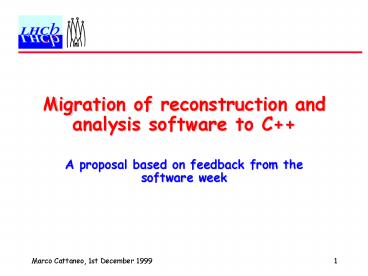Migration of reconstruction and analysis software to C - PowerPoint PPT Presentation
Title:
Migration of reconstruction and analysis software to C
Description:
Migration of reconstruction and analysis software to C++ A proposal based on feedback from the software week – PowerPoint PPT presentation
Number of Views:50
Avg rating:3.0/5.0
Title: Migration of reconstruction and analysis software to C
1
Migration of reconstruction and analysis software
to C
- A proposal based on feedback from the software
week
2
Immediate Goals
- Physics Goal
- To be able to run new tracking pattern
recognition algorithms written in C in
production with standard FORTRAN algorithms in
time to produce useful results for the RICH TDR. - Software Goal
- To allow software developers to become familiar
with GAUDI and to encourage the development of
new software algorithms in C.
3
Proposed Strategy - Step 1
- Finish splitting of SICB into
- simulation (SICBMC)
- Event generation, GEANT tracking
- outputs kinematics AND raw GEANT hits
- i.e. Current RAW format, but with xxRW banks from
all detectors - reconstruction (SICBREC)
- doesnt need GEANT3 nor its common blocks
- digitisation, trigger, reconstruction in distinct
steps - outputs same DST format as now.
- Benefits
- Clear separation between simulation and
reconstruction - Modularity of reconstruction
- Organiser Florence
4
Step 1 overview
SICBREC
SICBSIM
Half way between raw data and coordinates. E.g.
wire number, signed drift distance
Trigger
Entrance and exit points and energy loss in
detectors
5
Tasks for step 1
- SICBMC
- Remove anything that belongs to digitisation and
reconstruction - Done
- Create raw hits for calorimeter
- To be done by calorimeter experts (1 week?)
- SICBREC
- Add initialization routines for each step of the
processing (digitize, apply trigger,
reconstruction) - Verify validity of results
- Both the above are essentially work for the
sub-detector experts - Time estimate is about two weeks
- If started now, step 1 could be finished by Xmas
6
Step 1SICBREC structure
X
This dataflow is forbidden (no COMMON...)
Input
Output
SICB framework
7
Proposed Strategy - Step 2
- For every SICBREC FORTRAN module
- wrap it such that it can be called from C
- Integrate with the GAUDI framework
- Time estimate about 1 month - sub-detectors and
Gaudi team - Result is a new reconstruction program - BRUNEL
- Produce a DST (Zebra banks) with this program
- check the output is as expected
- i.e. identical to SICBREC output
- Must be done by sub-detector experts
- Drop SICBREC
- Could be ready for decision by next LHCb week
- Benefit
- Single environment for C and FORTRAN work
- Integrated environment for verification of C
developments - Organiser Marco
8
Step 2BRUNEL structure
Input
Output
Gaudi framework
9
Proposed Strategy - Step 3
- Start replacing FORTRAN modules with C
equivalent. Each new piece consists of - event model
- detector description
- algorithm.
- Provide converters to
- regenerate same SICB output bank that was there
before - Preserves format of SICB DST
- DST banks may contain improved data (e.g. Result
of tracking pattern recognition - Some added value of C algorithms would NOT be
on SICB DST - write data out to the supported persistent object
manager - Contains as complete a reconstructed event as is
available in GAUDI event store - Including added value of C algorithms,
available only to GAUDI based analyses
10
Step 3 - organisation
- This step implies (for each sub-detector)
- Development of event model help coordinated by
Marco - Development of detector description help
coordinated by Florence - Reviews of evt mod, det desc, algorithms
organised by John. - Review panel will include Pere, Marco, Florence,
plus SDs - Known candidates
- Tracking,
- Analysis tools,
- Muon digitisation,
- Calorimeters,
- RICH,
- ...
- Timescale
- Depends (almost) entirely on sub-detectors
11
Step 3BRUNEL structure
CDF files
Digitisation B
Trigger
Reconstruct B
Digitisation A
Zebra Input
Zebra Output
Sicb Converter
Sicb Converters
Sicb Converters
Reconstruct A
OO Output
BRUNEL
12
Step 3Analysis structure
Analysis A
Has access ONLY to SICB DST Steered by GAUDI job
options
GAUDI
Zebra Input
Sicb Converters
Sicb Converters
OO Input
Analysis B
Visualisation
Have access to OO DST and SICB banks for which
converters exist. Steered by GAUDI job options
13
Step 3 - benefits
- A unified development and production environment
- As soon as C algorithms are proven to do the
right thing, they can be brought into production
in the official reconstruction program - Early exposure of all developers to Gaudi
infrastructure - FORTRAN gurus and C beginners
- Increasing functionality of OO DST
- As more and more of the event data becomes
available in Gaudi, it will become more and more
attractive to perform analysis with Gaudi - N.B. Contains ALL (and only!) parts of
reconstructed event for which data model is
defined - A smooth transition to a C only reconstruction
14
Summary
- Step 1 separate SICBMC and SICBREC
- Could be ready by Xmas
- Step 2 wrap SICBREC algorithms into Gaudi
framework - Could be ready by end February
- Step 3 gradually replace FORTRAN with C
algorithms - Timescale dictated by sub-detector priorities
- Development/integration in Gaudi can start now
- Analysis in Gaudi is possible now
- Functionality will increase as subdetectors
define their data model - Analysis toolkit under development, send
requirements to Gloria































